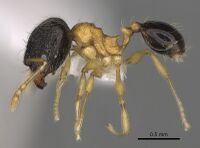Pheidole balatro
| Pheidole balatro | |
|---|---|

| |
| Scientific classification | |
| Kingdom: | Animalia |
| Phylum: | Arthropoda |
| Class: | Insecta |
| Order: | Hymenoptera |
| Family: | Formicidae |
| Subfamily: | Myrmicinae |
| Tribe: | Attini |
| Genus: | Pheidole |
| Species: | P. balatro |
| Binomial name | |
| Pheidole balatro Longino, 2019 | |
Pheidole balatro is Central American species inhabiting mature and second growth mesophyll cloud forests, variably mixed with pine, oak, and Liquidambar, from 650-1650 m elevation. It has been most commonly collected at baits on the forest floor and in Winkler samples of sifted leaf litter and rotten wood. Major workers commonly occur together with minor workers in baiting and Winkler samples. It can be locally abundant, occurring in a high proportion of samples.
Identification
Longino (2019) - Minor: face smooth and shiny; posterior margin of head mostly rounded with small medial emargination in face view; promesonotal groove absent; dorsal and lateral pronotum smooth and shiny; mesonotum and dorsal propodeum faintly foveolate; katepisternum mostly smooth and shiny, with strip of foveolation posteriorly; propodeal spines spiniform, about one third length of posterior face of propodeum; gaster smooth and shining; erect setae on mesosomal dorsum and gaster; tibiae without erect setae; bicolored, with sharply contrasting black head and gaster, light orange mesosoma.
Major: head somewhat heart-shaped, cordate, with strong posterior emargination; inner hypostomal teeth stout, closely spaced; scape base terete; face mostly foveolate overlain with rugulae, these longitudinal anteriorly, becoming reticulate posteriorly, sculpture fainter on vertex lobes; propodeal spines somewhat posteriorly directed, about one third length of posterior face of propodeum; gastral dorsum smooth and shining; sides of head with abundant short erect setae; abundant short erect setae on mesosomal dorsum and gaster; tibiae without erect setae; color as in minor worker.
Measurements, minor worker: HW 0.44, HL 0.46, SL 0.49, EL 0.11, WL 0.59, PSL 0.06, PTW 0.09, PPW 0.12, CI 95, SI 113, PSLI 13, PPI 122 (n=6).
Measurements, major worker: HW 0.81, HL 0.79, SL 0.52, EL 0.12, WL 0.72, PSL 0.08, PTW 0.13, PPW 0.18, CI 103, SI 64, PSLI 10, PPI 136 (n=5).
Measurements, queen: HW 0.81, HL 0.70, SL 0.57, EL 0.24, WL 1.19, PSL 0.08, PTW 0.23, PPW 0.33, CI 115, SI 71 (n=1).
DNA sequencing and morphology suggest that P. balatro and Pheidole tuxtlasana are sister species. Pheidole tuxtlasana is a lowland rainforest species occurring from Veracruz, Mexico to the Caribbean coast of Honduras. Pheidole balatro is a montane species that occurs from northern Honduras to northwestern Costa Rica. The two species occur in close proximity in northern Honduras, but segregate by elevation. Pheidole balatro is relatively abundant in Honduras. Beyond Honduras it is known from a single collection by Alex Smith in the Cordillera de Guanacaste, Costa Rica. Conspecificity of Honduran and Costa Rican populations is confirmed by COI barcoding. The species has not been recorded from Nicaragua, in spite of quantitative sampling in several montane sites. The Costa Rica population could be disjunct, or the species could be present in Nicaragua at low density and as yet escaping detection.
Pheidole balatro is part of a striking mimicry complex found in montane forests of Middle America, centered in Honduras. Pheidole zannia is another Honduran species that is common in montane sites, is about the same size as P. balatro, and shares the striking harlequin color pattern. The two species are often sympatric. They are distantly related, being phylogenetically widely separated. In each case their closest relatives do not have the harlequin pattern. Although not as common, in the same habitats there is an undescribed Tapinoma species and an undescribed Brachymyrmex species that also share the sharp harlequin pattern. These patterns are otherwise unknown in Tapinoma and Brachymyrmex.
Distribution
Latitudinal Distribution Pattern
Latitudinal Range: 14.93627° to 14.93492°.
| North Temperate |
North Subtropical |
Tropical | South Subtropical |
South Temperate |
- Source: AntMaps
Distribution based on Regional Taxon Lists
Neotropical Region: Costa Rica, Guatemala, Honduras.
Distribution based on AntMaps
Distribution based on AntWeb specimens
Check data from AntWeb
Countries Occupied
| Number of countries occupied by this species based on AntWiki Regional Taxon Lists. In general, fewer countries occupied indicates a narrower range, while more countries indicates a more widespread species. |

|
Estimated Abundance
| Relative abundance based on number of AntMaps records per species (this species within the purple bar). Fewer records (to the left) indicates a less abundant/encountered species while more records (to the right) indicates more abundant/encountered species. |

|
Biology
Castes
Worker
Minor
Images from AntWeb
   
| |
| Paratype. Worker (minor). Specimen code CASENT0635417. Photographer Michele Esposito, uploaded by California Academy of Sciences. | Owned by CAS, San Francisco, CA, USA. |
Nomenclature
The following information is derived from Barry Bolton's Online Catalogue of the Ants of the World.
- balatro. Pheidole balatro Longino, 2019: 24, fig. 12 (w.q.) HONDURAS.
Type Material
- HOLOTYPE: 1 major worker, Honduras, Olancho: 9km N Catacamas, 14.93492 -85.90708, ±50 m, 1350 m, 11 May 2010, mixed hardwood forest, at bait (Project LLAMA Ba-C-02-2-02-05) [CAS, unique specimen identifier CASENT0635416].
- PARATYPES: major, minor workers: same data as holotype [CAS, JTLC]; same data except 14.93627 -85.90477, ±50 m, 1330 m, 10 May 2010, second growth mixed hardwood forest, at bait (Project LLAMA Ba-C-02-3-01-01) [DZUP, JTLC, MCZC, USNM].
Description
see the identification section above
Etymology
In ancient Rome a balatro was a professional jester, in reference to the harlequin coloration.
References
References based on Global Ant Biodiversity Informatics
- Longino J. T. 2019. Pheidole (Hymenoptera, Formicidae) of Middle American wet forest. Zootaxa 4599: 1-126

